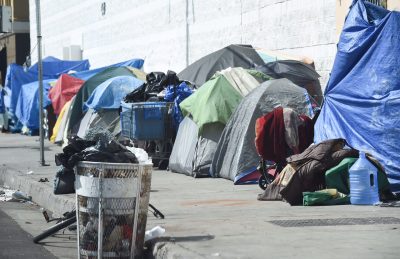;
(6-11-18) He first showed up several months ago holding a cardboard sign: “HOMELESS: Please Help!”
He was poised at the entrance of a neighborhood shopping center less than two miles from my house here in Fairfax, Virginia.
Next came several Washington Post articles about how homeless individuals were sleeping in cars and in tents within five miles from where I live.
Seeing this man homeless was good news.
What? How can I write such a horrible statement. Stick with me for a moment and you will understand.
I attended an awe inspiring summit last week held by the Corporation for Supportive Housing in Los Angeles, the so-called homeless capital of the United States.
It’s estimated that 53,000 homeless residents live there. If you have the courage to drive down skid row you will see third world conditions. The sidewalks are covered with tents and makeshift shelters. There are no bathrooms, no places to shower. Clearly psychotic residents can be seen yelling and wandering. Drug addicts and alcoholics slumber in the gutters. Dirty needles, human feces – you get the picture. 
It is a national disgrace.
In 2015, local, county and state leaders recognized the county and city were in crisis. Thankfully, CSH created a housing services financial model to assess what could be done. CSH showed billions were needed – that’s right billions.
In July 2016, the state took $2 billion out of the so-called millionaire’s tax pool to help pay for supportive housing.
In November 2016, voters in the city passed Proposition HHH, a $1.28 billion housing bond issue to create supportive housing.
In Marcy 2017, voters in the county passed Measure H, a quarter cent sales tax increase expected to generate $335 million per year for the next ten years to fund services and permanent housing.
Remember all of these public funded efforts were supported by voters.
During a briefing at the CSH summit by local officials, I gleaned two reasons for public support.
L.A.’s Mayor Eric Garcetti explained: “Voters realized we had a crisis.”
Dig deeper and you will learn why they came to that realization.
Homeless people began showing outside Skid Row. They invaded middle and upper class neighborhoods.
The Los Angles Times and other news outlets began putting human faces on the homeless by telling their stories and showing their squalid living conditions.
With CSH’s guidance, collaboration with dozens of other partners, and enthusiastic support from elected leaders (Mayor Garcetti and especially Supervisor Mark Ridley Thomas) – voters dug into their pockets and demanded something be done.
The result.
For the first time in four years, Los Angeles has seen a reduction in homelessness.
*16,519 people moved into homes in 2017, significantly more than the 10,917 in 2015.
*Veterans homelessness decreased by 18%.
*Chronic homelessness decreased by 16%.
*Youth placements into housing increased 43%.
CSH and its many financial backers, including the United Way of Los Angeles and the Conrad N. Hilton Foundation, have known for years how to fix this crisis. It is not complicated. You find places for individuals to live!
But it took the arrival of homeless individuals in middle and upper class neighborhoods to rally public support. I want the homeless man with his cardboard sign in my neighborhood to have a safe place to live.
I also realize his presence is a glaring wake up call for those of us in the suburbs that homelessness is not only an inner city problem.
(Thankfully, the leadership in Fairfax County, Virginia, has been working diligently to address homelessness. In 2017, for the first time in nine years, less than 1,000 people were reported as being homeless in Fairfax. That included 474 individuals in families, including 286 children. Another 490 were single individuals, including 155 older adults, age 55 and up.
(The count did not include those who were “couch surfing” – living in friend’s homes before being told to find somewhere else. Nor did it include those in jails.)
Full disclosure. I proudly serve on the board of directors of CSH.



